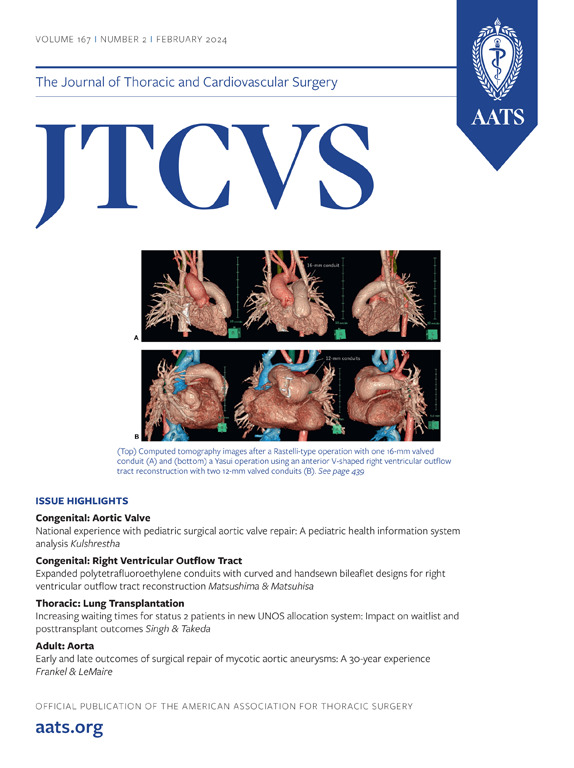中心位置小实体显性 cN0 非小细胞肺癌分段切除术与肺叶切除术的可行性和预后比较。
IF 4.9
1区 医学
Q1 CARDIAC & CARDIOVASCULAR SYSTEMS
Journal of Thoracic and Cardiovascular Surgery
Pub Date : 2025-02-01
DOI:10.1016/j.jtcvs.2024.06.016
引用次数: 0
摘要
研究目的本研究旨在确定对中心、整个肿瘤大小≤2 厘米且放射学上实性占优势的 cN0 非小细胞肺癌(NSCLC)患者进行分段切除术的可行性:我们回顾性研究了2010年1月至2022年12月期间因肿瘤较小且放射学上为实性占优势的cN0非小细胞肺癌而接受肺叶切除术或肺段切除术的1240例患者。纳入标准包括中心位置肿瘤,即位于肺实质内三分之二处的肿瘤。为了平衡基线特征,采用了倾向评分匹配法:在299名符合条件的患者中,无复发生存期(RFS)和总生存期(OS)在分段切除术组(n = 121)和肺叶切除术组(n = 178)之间无明显差异(P = .794和.577)。经过倾向评分匹配后,93 名匹配患者的肺门和纵隔淋巴结上分期无显著差异(P = 1.00),分段切除术组(n = 4)和肺叶切除术组(n = 4)的局部区域复发率相当。两组患者的RFS和OS无明显差异(P = 0.700和0.870)。倾向评分调整的RFS和OS多变量Cox分析表明,分段切除术不是独立的预后因素(RFS:危险比,0.89;95%置信区间,0.43-1.85;P = .755;OS:危险比,1.09;95%置信区间,0.38-3.14;P = .860):结论:对于经过适当选择的中心型、小(≤2厘米)、放射学上以实性为主的NSCLC患者,分段切除术可能是一种可行的治疗方案,其局部控制和预后与肺叶切除术相当。本文章由计算机程序翻译,如有差异,请以英文原文为准。
Feasibility and comparative prognosis of segmentectomy versus lobectomy in centrally located small and solid dominant cN0 non–small cell lung cancer
Objectives
To determine the feasibility of segmentectomy in patients with central, whole tumor size ≤2 cm and radiologically solid-dominant cN0 non–small cell lung cancer (NSCLC).
Methods
We retrospectively reviewed 1240 patients who underwent lobectomy or segmentectomy for small and radiologically solid-dominant cN0 NSCLC between January 2010 and December 2022. The inclusion criteria encompassed centrally located tumors, defined as tumors located in the inner two-thirds of the pulmonary parenchyma. Propensity score matching was applied to balance the baseline characteristics in the 2 study groups.
Results
Among the 299 eligible patients, no significant differences in recurrence-free survival (RFS) and overall survival (OS) were observed between the segmentectomy (n = 121) and lobectomy (n = 178) groups (P = .794 and .577, respectively). After propensity score matching, no significant differences in hilar and mediastinal lymph node upstaging were found among the 93 matched patients (P = 1.00), and locoregional recurrence was comparable in the segmentectomy (n = 4) and lobectomy (n = 4) groups. RFS and OS did not differ significantly between the 2 groups (P = .700 and .870, respectively). Propensity score–adjusted multivariable Cox analysis for RFS and OS indicated that segmentectomy was not an independent prognostic factor (RFS: hazard ratio [HR], 0.89; 95% confidence interval [CI], 0.43-1.85; P = .755; OS: HR, 1.09; 95% CI, 0.38-3.14; P = .860).
Conclusions
Segmentectomy may be a viable treatment option, with local control and prognosis comparable to that of lobectomy in appropriately selected patients with central, small (≤2 cm), and radiologically solid-dominant NSCLC.
求助全文
通过发布文献求助,成功后即可免费获取论文全文。
去求助
来源期刊
CiteScore
11.20
自引率
10.00%
发文量
1079
审稿时长
68 days
期刊介绍:
The Journal of Thoracic and Cardiovascular Surgery presents original, peer-reviewed articles on diseases of the heart, great vessels, lungs and thorax with emphasis on surgical interventions. An official publication of The American Association for Thoracic Surgery and The Western Thoracic Surgical Association, the Journal focuses on techniques and developments in acquired cardiac surgery, congenital cardiac repair, thoracic procedures, heart and lung transplantation, mechanical circulatory support and other procedures.

 求助内容:
求助内容: 应助结果提醒方式:
应助结果提醒方式:


